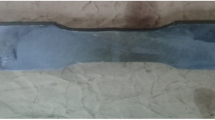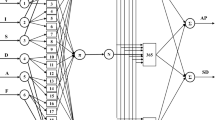Abstract
Reduced-activated ferritic-martensitic steels are considered to be the prime candidate for structural material of the fusion power plant reactor design. Tungsten inert gas (TIG) welding is preferred for welding of those structural materials. However, the depth of penetration achievable during autogenous TIG welding is very limited and hence productivity is poor. Therefore, activated-flux tungsten inert gas (A-TIG) welding, a new variant of TIG welding process has been developed in-house to increase the depth of penetration in single pass welding. In structural materials produced by A-TIG welding process, weld bead width, depth of penetration and HAZ width decide the mechanical properties and in turn the performance of the weld joints during service. To obtain the desired weld bead geometry, HAZ width and make a reliable quality weld, it becomes important to develop predictive tools using soft computing techniques. In this work, adaptive neuro fuzzy inference system is used to develop independent models correlating the welding parameters like current, voltage and torch speed with bead shape parameters like weld bead width, depth of penetration, and HAZ width. During ANFIS modeling, various membership functions were used. Triangular membership function provided the minimum RMS error for prediction and hence, ANFIS model with triangular membership functions were chosen for predicting for weld bead shape parameters as a function of welding process parameters.





Similar content being viewed by others
References
Klueh R L, and Harries D R, High-chromium ferritric and martensitic steels for nuclear applications, American Society for Testing and Materials, West Conshohocken (2001).
King R T, Gray R J, Crouse R S, and Sikka V K, in Symposium on structural material for service at elevated temperatures in nuclear power generation, (ed) Schaefer A O, American society of Mechanical Engineering, New York (1975), p 375.
Klueh R L, Elevated temperature ferritic and martensitic steels and their application to future nuclear reactors, ORNC/TM-2004/176, Metals & Ceramics Division, Oakridge National Laboratory, November (2004).
Kumar A, and Sundarajan S, Int J Adv Manu Technol (2008). doi:10.1007/s00170-008-1527-8.
Tarang Y S, and Yang W H, Int J Adv Manuf Technol 14 (1998) 549.
Lucas W, Weld Metal Fabr 68(2) (2000) 7.
Paskell T, Lundin C, and Castner H, Weld J 76(4) (1997), 57.
Vasudevan M, Computational and experimental studies on arc welded austenitic stainless steels, Ph.D. thesis, Indian Institute of Technology, Chennai (2007).
Vasudevan M, Bhaduri A K, and Raj B, Developmental evaluation of activated flux for TIG welding of type 304LN and 316LN stainless steels. Proceeding of the International congress, International Institute of Welding, Chennai (2008).
Vasudevan M, and Raj B, IIM Metal News 12 (2009) 15.
Vasudevan M, Mater Manuf Process 24 (2009) 209.
Chakraboorthi N, Int Mater Rev 49(3–4) (2004) 246.
Odejobi O A, and Umoru L E, Afr J Math Comput Sci Res 2(7) (2009) 104.
Datta S, Pettersson F, Ganguly S, Saxen H, and Chakraborthi N, ISIJ Int 47 (2007) 1193.
Dey S, Datta S, Chattopadhyay P P, and Sil J, Comput Mater Sci 43 (2008) 501.
Hancheng Q, Bocai X, Shangzheng L, and Fagen W, J Mater Process Technol 122 (2002) 196.
Chen M Y, and Linkens D A, ISIJ Int 46 (2006) 586.
Vasudevan M, Kuppuswamy M V, and Bhaduri A K, Trans Indian Inst Metals 63(1) (2010) 1.
Bag S, and De A, Sci Technol Weld Join 14 (2009) 633.
Author information
Authors and Affiliations
Corresponding author
Rights and permissions
About this article
Cite this article
Vishnuvaradhan, S., Chandrasekhar, N., Vasudevan, M. et al. Intelligent Modeling Using Adaptive Neuro Fuzzy Inference System (ANFIS) for Predicting Weld Bead Shape Parameters During A-TIG Welding of Reduced Activation Ferritic-Martensitic (RAFM) Steel. Trans Indian Inst Met 66, 57–63 (2013). https://doi.org/10.1007/s12666-012-0178-x
Received:
Accepted:
Published:
Issue Date:
DOI: https://doi.org/10.1007/s12666-012-0178-x




